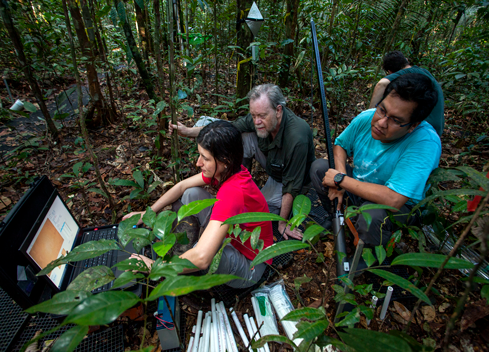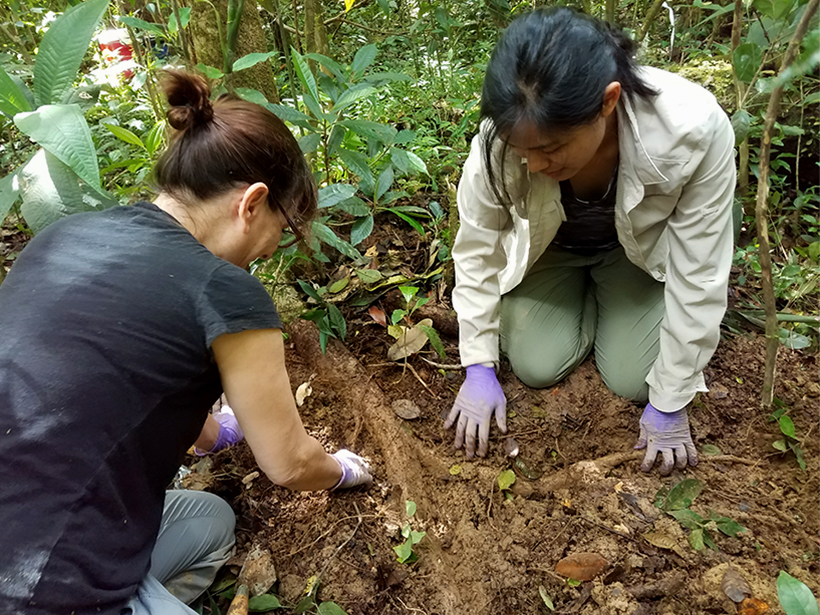When the U.S. Department of Energy’s (DOE) $100 million Next-Generation Ecosystem Experiment–Tropics (NGEE-Tropics) launched in 2015, Ariel Lugo, an ecologist and director of the International Institute of Tropical Forestry (IITF) in Río Piedras, Puerto Rico, was excited. He felt that the project’s large budget and international scope might help it take on one of the field’s long-standing challenges: helping computer models accurately represent how tropical forests will respond to climate change. “DOE can bring a lot of money to a problem in a hurry,” Lugo says.

The project has funded, among other things, studies of soil processes at the Luquillo Experimental Forest in Río Piedras and airborne data-gathering campaigns over the entire island of Puerto Rico. It has also paid for Lugo and his colleagues to attend meetings with computer modelers and make sure they are collecting the right kinds of data.
The project has brought together more than 130 scientists from five of DOE’s 17 national laboratories as well as external organizations, including the U.S. Forest Service’s IITF, the Smithsonian Tropical Research Institute in Panama, and the National Institute for Amazonian Research (INPA) in Manaus, Brazil.
The plan was for it to run until 2025. But this spring, sometime after the release of the White House’s 2018 budget request in May, the NGEE-Tropics project’s leaders began telling collaborators the project would shut down in 2018. The project is slated to end 7 years ahead of schedule.
Tropical Model Muddle
Project leaders say the need for NGEE-Tropics is great. Tropical forests cover 7% of Earth’s land surface and store between 225 and 250 billion tons of carbon as wood, making them major players in the climate system. “If your goal is to build a more accurate Earth system model, it’s actually really important to get the tropics right,” said Jeff Chambers, a climate scientist at Lawrence Berkeley National Laboratory in California and the project’s director.
“Almost any global model, no matter what you’re modeling, whether it be carbon dioxide, whether it be temperature changes—the predictions that are made, they always diverge in tropics.”
But the massive computer simulations that scientists build to forecast Earth’s future make inconsistent predictions about whether tropical forests will absorb or release carbon in the future. “Almost any global model, no matter what you’re modeling, whether it be carbon dioxide, whether it be temperature changes—the predictions that are made, they always diverge in tropics,” Lugo said.
The outcomes depend on assumptions about how trees and soil microbes will respond to higher temperatures, higher carbon dioxide levels, changes in rainfall and nutrient levels, and other factors. To improve how models represent these processes, Lugo and other project scientists have designed studies to tease out data on how factors such as soil nutrients, water movement, and root decomposition influence forest growth and carbon release.
Productive Project, Fleeting Funding
During the 2.5 years that NGEE-Tropics has operated, project-funded scientists have been involved in nearly 60 peer-reviewed publications, according to the project’s website. The project has built a portal to provide data to the wider research community and released an initial version of its Functionally Assembled Terrestrial Ecosystem Simulator (FATES), a tropical ecosystem model incorporating collected data that is intended to be part of DOE’s full-scale Earth system model.
But the Trump administration’s budget proposal for fiscal year (FY) 2018, released on 23 May, zeroed out NGEE-Tropics. Even though Congress has yet to pass a final 2018 budget (the government is funded through 22 December by last week’s continuing resolution, which maintains 2017 funding levels), Gary Geernaert, director of the department’s Climate and Environmental Sciences Division, told Eos that the project will end.
“It’s not ending because of lack of productivity. It’s the funding environment in Washington these days, I think.”
Richard Norby, an ecologist at Oak Ridge National Laboratory in Tennessee and a lead scientist on the project, was not privy to the discussions that led to its termination. But he said that he suspects that the decision reflects a political bias against funding research in the tropics. The United States has only one relatively small tropical rain forest—the one that Lugo studies in Puerto Rico.
“It’s disappointing,” said Norby, who has been leading the NGEE-Tropics research on nutrient constraints. “It’s not ending because of lack of productivity. It’s the funding environment in Washington these days, I think.”
Hot and Cold
NGEE-Tropics was inspired by DOE’s Next-Generation Ecosystem Experiment–Arctic, a project that the agency launched in 2012 to study how the Arctic will respond to future warming. The Arctic project remains funded in the president’s budget, although at $5.8 million per year compared with its previous level of $10 million per year.
Program officers at DOE headquarters in Washington, D. C., declined multiple interview requests. In response to an email asking why NGEE-Tropics was terminated while NGEE-Arctic was not, Geernaert wrote, “The Arctic program has been in existence longer and has direct relevance to issues of energy security.”
Although department officials did not specify which issues, NGEE-Arctic funds research in Alaska, a state that produces a large amount of oil and natural gas, where global warming could cause permafrost to thaw, potentially releasing vast stores of underground carbon. Tax reform legislation currently under consideration in Congress could expand oil drilling into the Arctic National Wildlife Refuge in northeastern Alaska.
The tropics have no similar strategic importance to U.S. energy production, However, Lugo and Norby believe that understanding how they will respond to the changing climate remains important. Although the Forest Service and other institutions such as INPA, the Smithsonian, and Oxford University in the United Kingdom will continue to run their own tropical forest research programs, the decision to ax NGEE-Tropics will mean that scientists who make observations collaborate less with those who build models in the future, Norby said.
Mitigation and Adaptation
As the project winds down, its scientists are wrapping up research campaigns and searching for alternate sources of funding.
As the project winds down, its scientists are wrapping up research campaigns and searching for alternate sources of funding. A major concern, said Norby, is figuring out how to ensure that graduate students who have worked on the project are able to complete their dissertation work. “My highest priority…is to make sure I have sufficient funds to support them,” he said.
Even if NGEE-Tropics ends, its products will continue to benefit the scientific community, Chambers said. With additional development, the FATES model could simulate temperate and boreal forest or nonforest vegetation. “There are a lot of different ways you can improve Earth system models,” he said.
—Gabriel Popkin ([email protected]), Freelance Science Journalist
Citation:
Popkin, G. (2017), Major federal tropical research project to cease 7 years early, Eos, 98, https://doi.org/10.1029/2017EO088505. Published on 11 December 2017.
Text © 2017. The authors. CC BY-NC-ND 3.0
Except where otherwise noted, images are subject to copyright. Any reuse without express permission from the copyright owner is prohibited.

